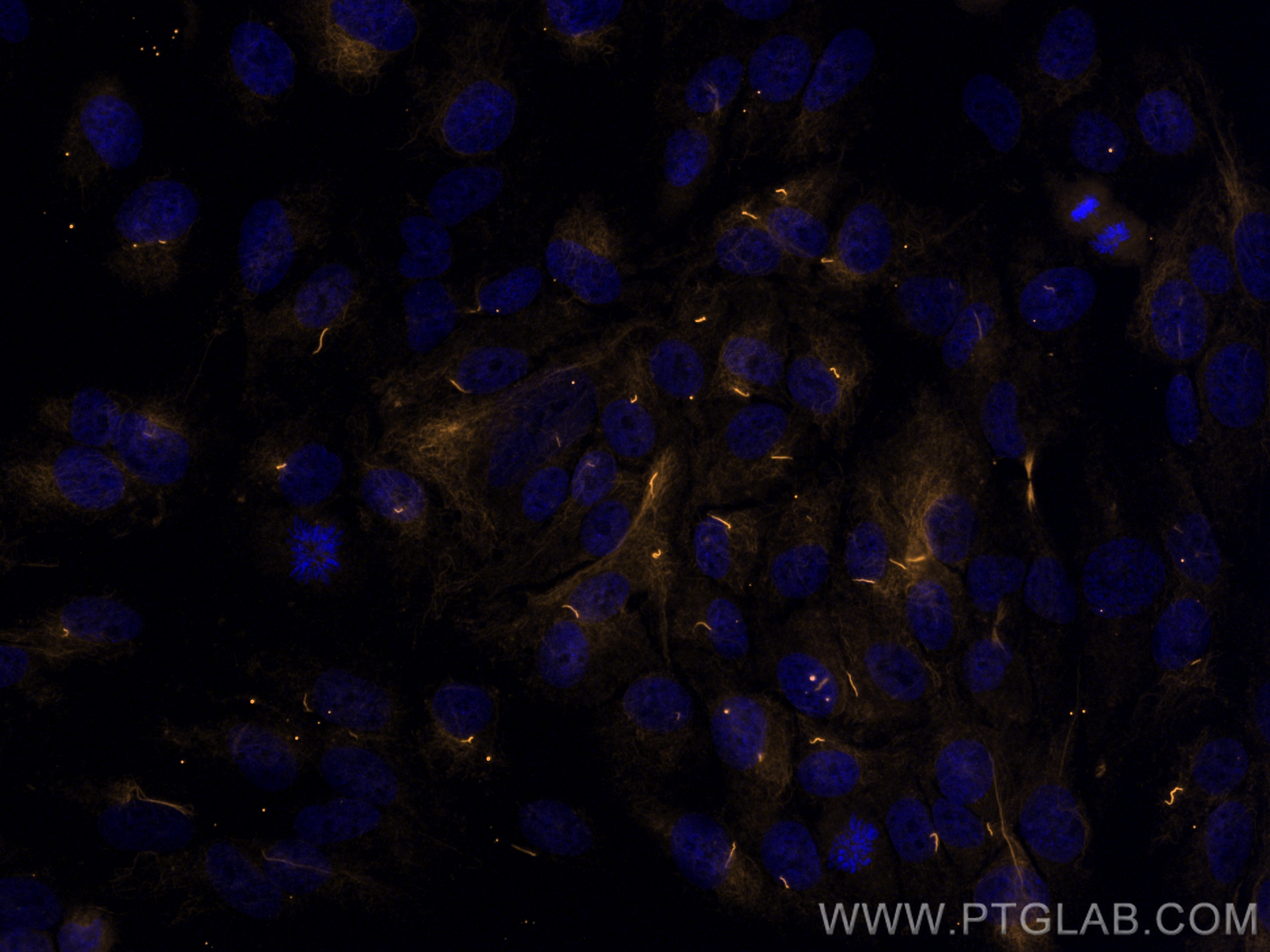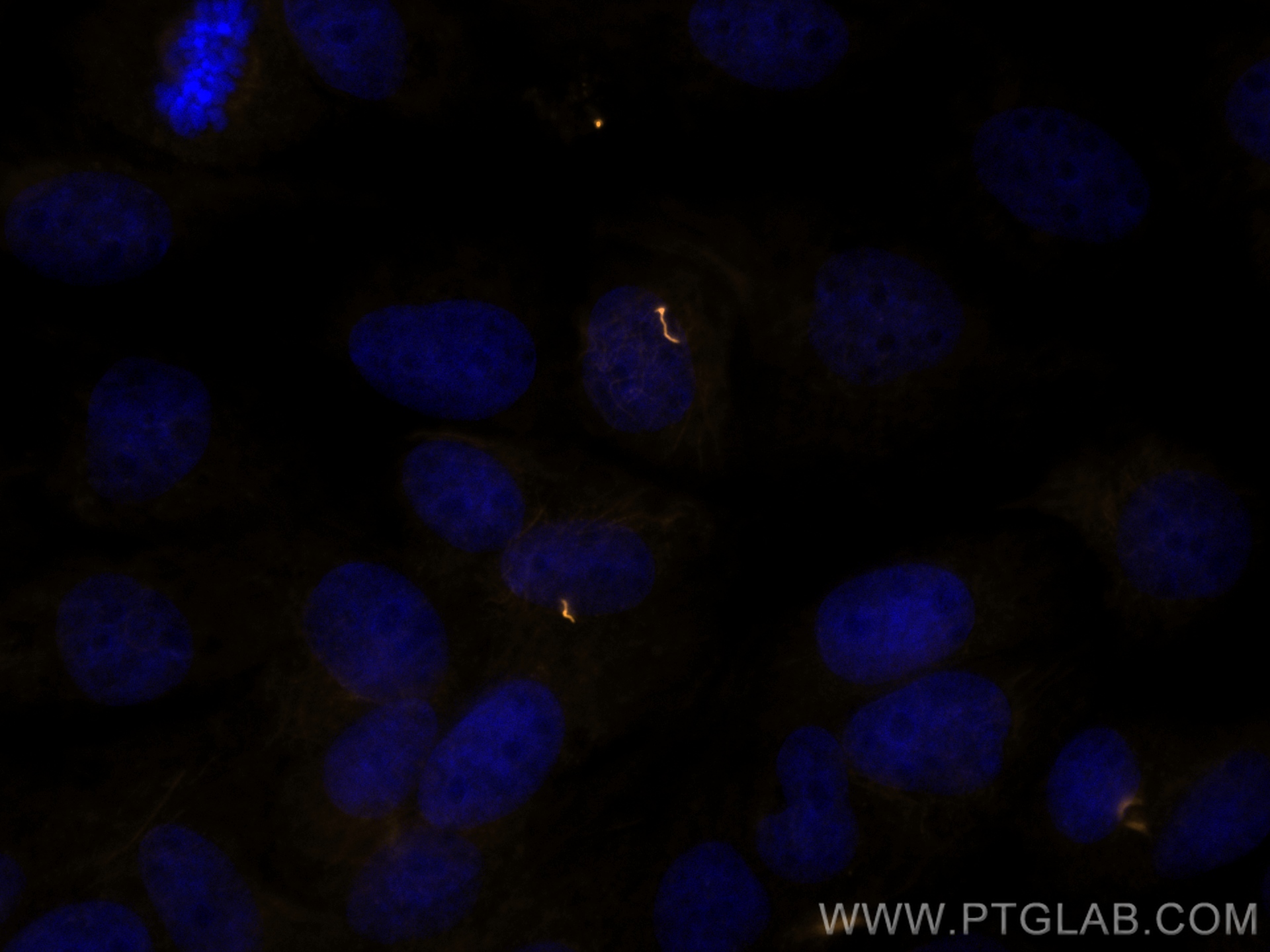验证数据展示
经过测试的应用
| Positive IF/ICC detected in | MDCK cells, hTERT-RPE1 cells |
推荐稀释比
| 应用 | 推荐稀释比 |
|---|---|
| Immunofluorescence (IF)/ICC | IF/ICC : 1:50-1:500 |
| It is recommended that this reagent should be titrated in each testing system to obtain optimal results. | |
| Sample-dependent, Check data in validation data gallery. | |
产品信息
CL555-66200 targets Acetyl-Tubulin (Lys40) in IF/ICC applications and shows reactivity with human, mouse, rat, pig, canine samples.
| 经测试应用 | IF/ICC Application Description |
| 经测试反应性 | human, mouse, rat, pig, canine |
| 免疫原 |
Peptide 种属同源性预测 |
| 宿主/亚型 | Mouse / IgG1 |
| 抗体类别 | Monoclonal |
| 产品类型 | Antibody |
| 全称 | tubulin, alpha 1a |
| 别名 | Ac Tubulin (Lys40), Ac Tubulin Lys40, Acetyl Tubulin, Acetyl Tubulin (Lys40), Acetyl Tubulin Lys40 |
| 计算分子量 | 52 kDa |
| 观测分子量 | 50-55 kDa |
| GenBank蛋白编号 | NM_006009 |
| 基因名称 | Alpha Tubulin |
| Gene ID (NCBI) | 7846 |
| RRID | AB_2919679 |
| 偶联类型 | CoraLite®555 Fluorescent Dye |
| 最大激发/发射波长 | 557 nm / 570 nm |
| 形式 | Liquid |
| 纯化方式 | Protein G purification |
| UNIPROT ID | Q71U36 |
| 储存缓冲液 | PBS with 50% glycerol, 0.05% Proclin300, 0.5% BSA, pH 7.3. |
| 储存条件 | Store at -20°C. Avoid exposure to light. Stable for one year after shipment. Aliquoting is unnecessary for -20oC storage. |
背景介绍
What is the molecular weight of acetyl-α-tubulin?
The molecular weight of acetylated tubulin is 52 kD.
Where does the acetylation of Lys 40 occur?
This acetylation occurs inside the microtubule lumen by the α-tubulin acetyltransferase 1 (αTAT1) (PMID: 29207274).
How can acetylation be reversed?
Acetylation of Lys 40 can be reversed by deacetylase 6 (HDAC6), which is mostly cytoplasmic that also deacetylates Hsp90, and sirtuin 2 (SIRT2), which also mainly cytoplasmic and uses NAD as a coenzyme. Unlike HDAC6, SIRT uses both polymerized and soluble tubulin as substrates. Deacetylases are believed to be more active on soluble tubulin, while acetylases function preferentially on stable polymers (PMIDs: 29207274, 30079247, 19185337).
What is the function of acetylation?
Acetylation is a conserved post-translational modification of alpha tubulin at Lys 40 during tubulin assembly, and it correlates to increased microtubule stability and intracellular transport (PMIDs: 29207274, 30079247, 20940043).
Is acetylation of α-tubulin strictly associated with stable microtubules?
Not necessarily, as acetylation can have other effects on microtubule subpopulations (PMID 20940043).
Is ac-tubulin found only in cilia?
Acetylated-α-tubulin is located in cytoplasmic tubulin as well as in cilia; therefore, it is not strictly region-specific (PMID: 30079247).
What are the cellular effects of tubulin acetylation?
Microtubule acetylation seems to provide a critical role in neuronal development and function, and while its effect on cancer cells remains unclear, it has been shown that decreased acetylated α-tubulin impairs neuronal cell line migration. The post-translational modification may also help regulate organelle-independent signalling throughout the cell, supporting the notion of a microtubule network serving as a coordinator of cellular signaling (PMIDs: 29207274, 25503560, 20940043, 19185337).
实验方案
| Product Specific Protocols | |
|---|---|
| IF protocol for CL555 Acetyl-Tubulin (Lys40) antibody CL555-66200 | Download protocol |
| Standard Protocols | |
|---|---|
| Click here to view our Standard Protocols |



